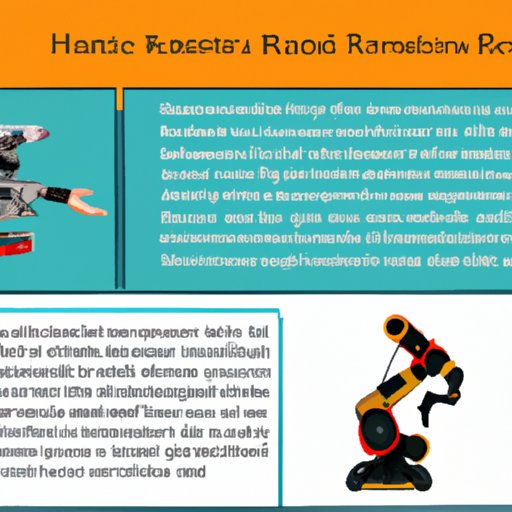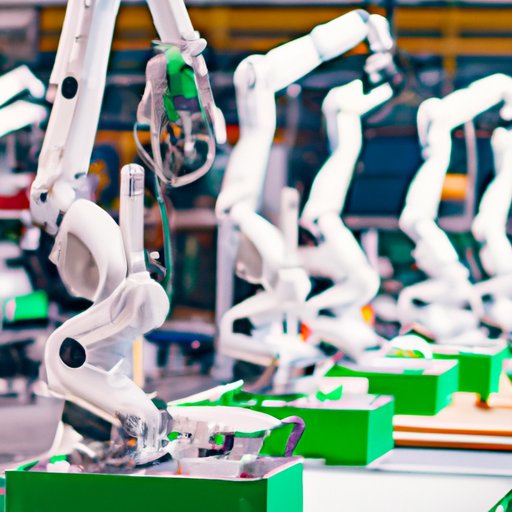Introduction
Industrial robots are widely used in manufacturing and production processes in many industries, such as automotive, electronics, and food processing. They are a technological advancement that increases productivity and quality while reducing labor costs and safety risks. But how much do industrial robots cost? This article will explore the different types of industrial robots and their average price, as well as the factors that influence the cost, cost comparisons of different models, benefits of investing in industrial robots, and how to save money.
Overview of Industrial Robot Types and Their Average Cost
Industrial robots vary in size, shape, and function. According to the International Federation of Robotics (IFR), there are four main types of industrial robots: Cartesian, cylindrical, SCARA, and articulated. The most common type is the articulated robot, which consists of several joints connected by an arm. The average cost of an articulated robot ranges from $50,000 to $100,000. The other types of robots cost around the same amount.

Factors That Influence the Cost of Industrial Robots
The cost of an industrial robot depends on several factors. These include the price of the robot model, installation and setup costs, training and maintenance costs, and the quality of parts and materials used. It’s important to consider all these factors when deciding on a budget.
Price of the Robot Model
The price of the robot model is the first factor to consider when determining the cost of an industrial robot. The price can range from $25,000 for a small robot to over $200,000 for a large robot. The cost also varies depending on the features and capabilities of the robot.
Installation and Setup Costs
Installing and setting up an industrial robot can be a costly process. Depending on the complexity of the process, it can cost anywhere from $10,000 to $50,000. Installation costs can also vary depending on the type of robot and the environment in which it needs to be installed.
Training and Maintenance Costs
Training and maintenance costs are often overlooked when calculating the cost of an industrial robot. Training staff to use the robot properly and safely can cost between $1,000 and $5,000. Additionally, regular maintenance and repairs can cost around $2,000 per year.
Quality of Parts and Materials
The quality of components and materials used in an industrial robot can also have an impact on its cost. High-quality parts and materials can increase the cost of the robot, while lower-quality parts can reduce the cost. It’s important to research the quality of the components before making a purchase.
Cost Comparison of Different Industrial Robot Models
The cost of industrial robots can vary significantly depending on the size and type of robot. Smaller robots, such as the ABB IRB 1200, cost around $35,000. Medium-sized robots, like the Fanuc LR Mate 200iC, typically cost between $75,000 and $125,000. Finally, large industrial robots, like the KUKA KR 10 R1400, can cost upwards of $200,000.

Benefits of Investing in Industrial Robots and What to Consider When Purchasing
Investing in industrial robots can provide many benefits, including increased productivity, improved quality, reduced labor costs, versatility, safety, and reliability. Before purchasing an industrial robot, it’s important to consider the size, type, and features that are best suited for the task at hand.
Increased Productivity
Industrial robots can increase productivity by eliminating human error and increasing the speed of production. According to a study by the University of Southern California, “the use of robotic automation in manufacturing has been shown to increase productivity by up to 25%.”
Improved Quality
Industrial robots are highly accurate and precise, which makes them ideal for tasks that require repeatability and consistency. This helps to improve the quality of products and reduce waste. A study conducted by the Massachusetts Institute of Technology found that “robots can improve product quality by up to 40%.”
Reduced Labor Costs
Industrial robots can significantly reduce labor costs by eliminating the need for manual labor. According to the National Association of Manufacturers, “automation can reduce labor costs by up to 30%.” Furthermore, robots can work 24 hours a day, 7 days a week, which further reduces labor costs.
Versatility
Industrial robots can be programmed to perform multiple tasks, making them extremely versatile. This allows them to be used in a variety of applications, such as welding, painting, assembly, and inspection.
Safety
Industrial robots are designed to be safe and reliable, which reduces the risk of accidents and injuries. According to the International Organization for Standardization (ISO), “the use of robots in hazardous environments can reduce the risk of injury by up to 90%.”
Reliability
Industrial robots are designed to be reliable and durable, which minimizes downtime and increases productivity. According to the National Institute of Standards and Technology (NIST), “robots are estimated to have a mean time between failures of up to 1 million hours.”
How to Save Money on Industrial Robots
Buying an industrial robot can be expensive, but there are ways to save money. Here are some tips to help you save money when purchasing an industrial robot:
Research and Compare Prices
Before buying an industrial robot, it’s important to research and compare prices. Look for deals and discounts offered by manufacturers and retailers. You should also compare the features and capabilities of different models to ensure you get the best value for your money.
Opt for Used or Refurbished Industrial Robots
Used and refurbished industrial robots are often much cheaper than new models. They may not have the latest features, but they can still be a good option for those on a tight budget.
Negotiate with Manufacturers
Manufacturers are often willing to negotiate on the price of an industrial robot. Don’t be afraid to negotiate and try to get the best deal possible.

Review of the Top 5 Most Affordable Industrial Robots
Here are five of the most affordable industrial robots on the market:
ABB IRB 1200
The ABB IRB 1200 is a small, lightweight industrial robot that is suitable for a variety of applications. It has a maximum payload of 12 kg and can reach speeds of up to 4 m/s. The average price of this robot is around $35,000.
Fanuc LR Mate 200iC
The Fanuc LR Mate 200iC is a medium-sized industrial robot that is ideal for welding and material handling tasks. It has a maximum payload of 10 kg and can reach speeds of up to 3 m/s. The average price of this robot is around $75,000-$125,000.
Universal Robots UR10e
The Universal Robots UR10e is a large industrial robot that is perfect for heavy-duty tasks such as palletizing and machine tending. It has a maximum payload of 10 kg and can reach speeds of up to 4 m/s. The average price of this robot is around $45,000.
KUKA KR 10 R1400
The KUKA KR 10 R1400 is a large industrial robot that is perfect for heavy-duty tasks such as welding and machining. It has a maximum payload of 14 kg and can reach speeds of up to 5 m/s. The average price of this robot is around $200,000.
DENSO VS-060N
The DENSO VS-060N is a small industrial robot that is suitable for a variety of applications. It has a maximum payload of 6 kg and can reach speeds of up to 2.5 m/s. The average price of this robot is around $30,000.
Conclusion
Industrial robots are becoming increasingly popular in factories and production lines due to their accuracy and efficiency. The cost of an industrial robot depends on several factors, including the price of the robot model, installation and setup costs, training and maintenance costs, and the quality of parts and materials used. Smaller robots cost around $35,000, while large industrial robots can cost upwards of $200,000. Investing in industrial robots can provide many benefits, including increased productivity, improved quality, reduced labor costs, versatility, safety, and reliability. There are also ways to save money when purchasing an industrial robot, such as researching and comparing prices, opting for used or refurbished robots, and negotiating with manufacturers.
Overall, industrial robots are a great investment for businesses looking to increase efficiency and reduce labor costs. It’s important to consider all the factors and research the available options before making a purchase.
(Note: Is this article not meeting your expectations? Do you have knowledge or insights to share? Unlock new opportunities and expand your reach by joining our authors team. Click Registration to join us and share your expertise with our readers.)
